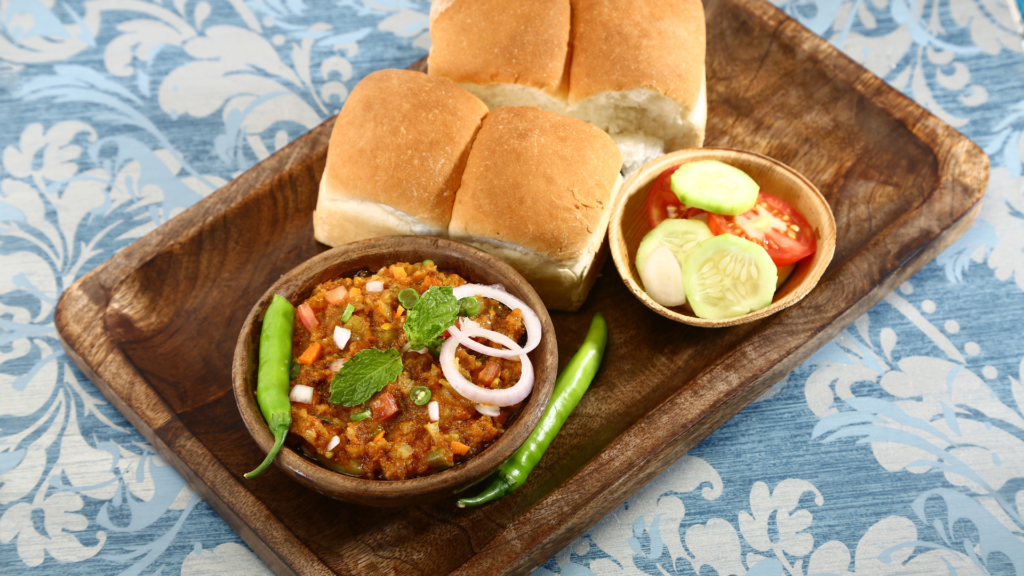Introduction
Street food pav bhaji is delicious, but you must be careful where you eat it. It’s always better to go with a local and get their recommendation, or at least ask where they like to eat. In Mumbai (and other cities), there are some stalls that have been around for decades that serve delicious street food! This is one of my favorite ones:

While the origin of pav bhaji is debatable, some people say the dish started in Navi Mumbai, so I’ll claim it!
While the origin of pav bhaji is debatable, some people say the dish started in Navi Mumbai, so I’ll claim it! In any case, pav bhaji was popularized by street vendors in Mumbai and has since spread across India. It’s a bit like dosa or idli, a staple now found all over the country.
Further Reading: Easy, healthy, & Quick Pav Bhaji Recipe
The ingredient that gives this dish its distinctive taste is butter.
The ingredient that gives this dish its distinctive taste is butter. Butter is used to make the bhaji and for making the pavs. It gives the dish a creaminess that is hard to replicate with other ingredients, like oil or ghee (clarified butter). Butter is also used in many Indian dishes, but pav bhaji is one of its best-known uses.
The veggies used in the authentic street-style recipe are potatoes, carrots, green beans, cauliflower, peas, and bell peppers. As you can see from the ingredients list above, there is no onion or tomato in pav bhaji. This is because it is a spicy dish, and onions would make it even spicier than it already is.
If you are using a pressure cooker for cooking your bhaji, don’t forget to add some salt, as this will help retain its color during the cooking process. If you do not have a pressure cooker, add some salt after blending all the vegetables with water into a smooth paste, which should be done before frying them in oil.
Further reading: Chicken Curry Rice: A Traditional Healthy and Comforting Meal
The spices used include coriander seeds/powder, cumin seeds/powder, and turmeric powder.
The spices used include coriander seeds/powder, cumin seeds/powder, and turmeric powder.
Coriander seeds are used more than cumin seeds in the spice mix due to their pungent and earthy taste. Cumin adds a strong aroma to the dish while adding a bit of heat. Turmeric powder adds color and gives a tangy flavor to this street food dish from Mumbai.

The bhaji (veggie mixture)
The bhaji should be tangy and spicy with a bit of sweetness from the tomatoes. Butter provides a creaminess to the mixture that coats the veggies when mashed together.
Butter also adds an extra depth of flavor, but you can easily substitute it with oil or ghee if you’re looking for a vegan version!
Further reading: 4 Reasons why veg Chinese cuisine is the superior choice
The best way to eat Mumbai style Pav Bhaji
The best way to eat this dish is with warm pav (dinner rolls) on the side. One bite of pav and bhaji followed by an extra dab of butter on the pav will make you wonder why you didn’t come to Mumbai sooner!
Pav is a bread roll made in a tandoor oven, usually in South Asia and East Africa. It’s made from maida flour and water, sometimes supplemented with baking powder or yeast to help it rise more quickly; then, it’s baked until it has a golden crust on one side. Some recipes also call for adding oil before putting them into the oven, which adds flavor and makes them softer than regular sandwich rolls.
Eat at some stalls in Mumbai while they still sell street food. They’re shutting them down everywhere in India.
If you’re visiting Mumbai, you should try to eat street food. It’s a great experience, and there are so many options! You can get everything from pav bhaji (toasted bread with vegetables) to vada pav (a burger made with fried lentil fritters).

But if you want to make sure that your favorite Mumbai-style street food is still available when you visit the city, act fast. In that case, street food stalls are disappearing all over India because of health concerns and environmental issues.
Further reading: The Ultimate Guide On How to Cook Kohlapuri Chicken for Beginners
Conclusion
If you’re a foodie, visiting Mumbai is a must. It’s one of the best places in India for street food. But if you want to ensure that your favorite Mumbai-style street food is still available when you visit, act fast—street food stalls are disappearing all over India because of health concerns and environmental issues.

2 thoughts on “Mumbai style street Pav Bhaji, Why it’s the best.”
Pingback: The History and Origins of Chicken Pav Bhaji - EatFIt
Pingback: Chicken Pav Bhaji Vs. Traditional Pav Bhaji: What's The Difference